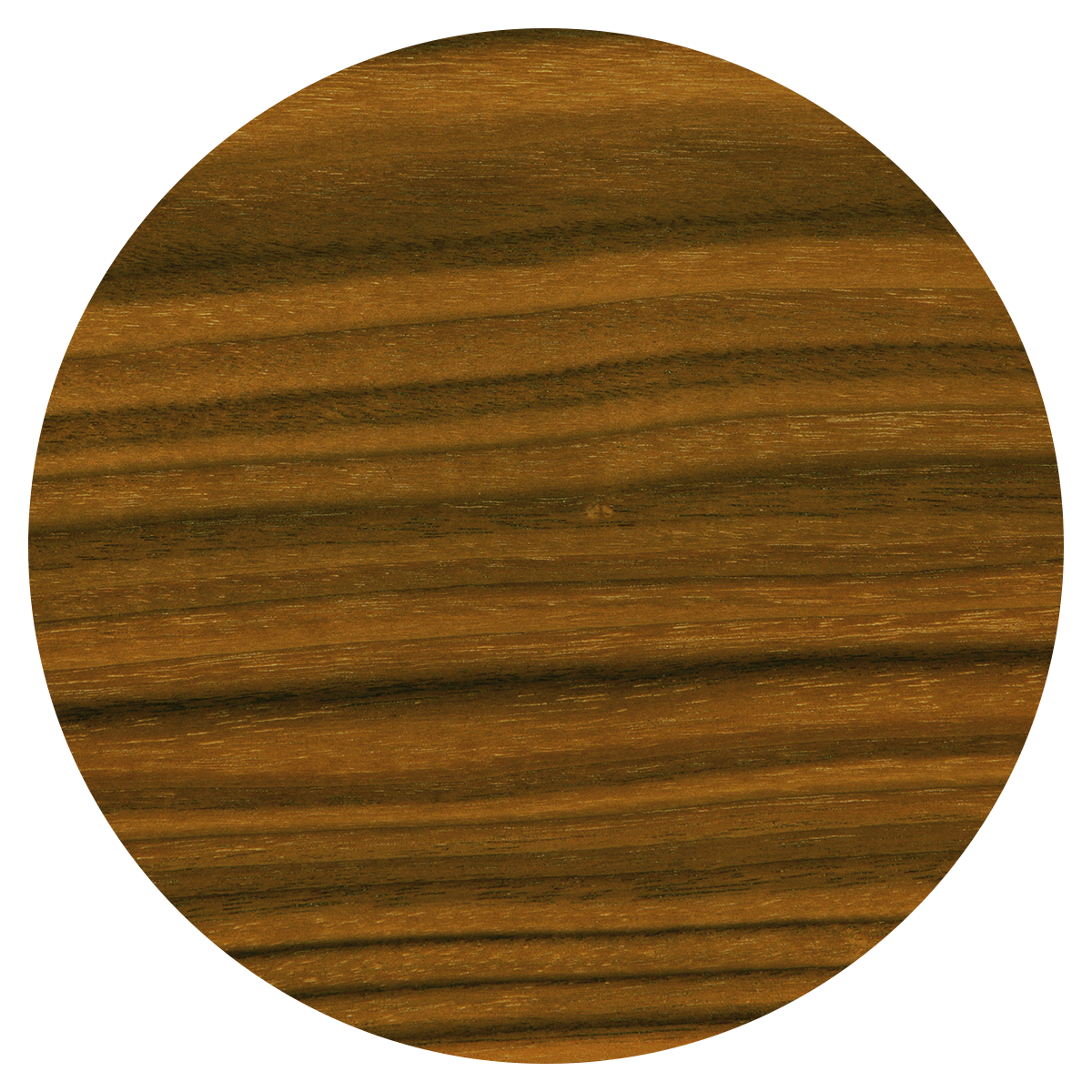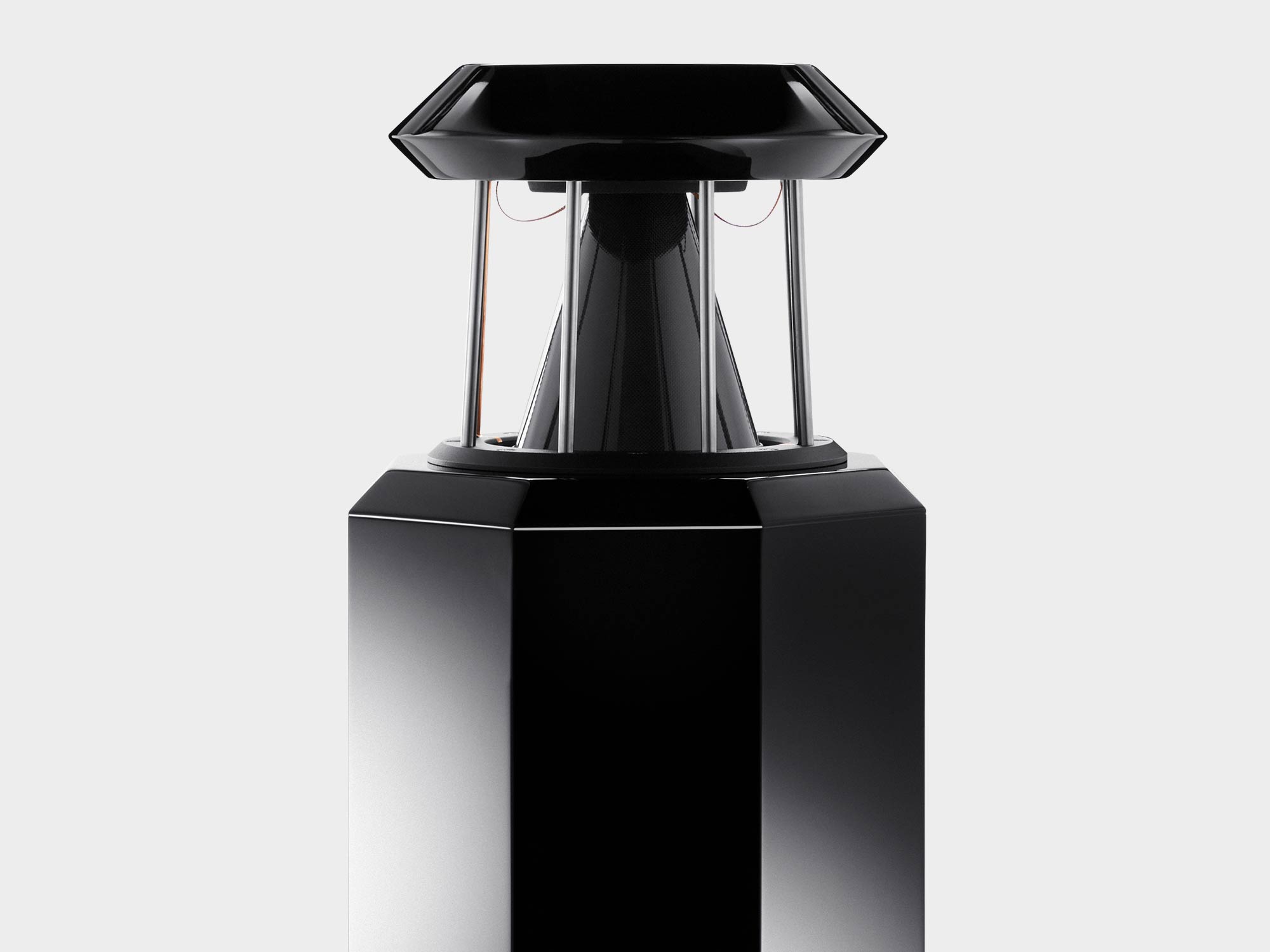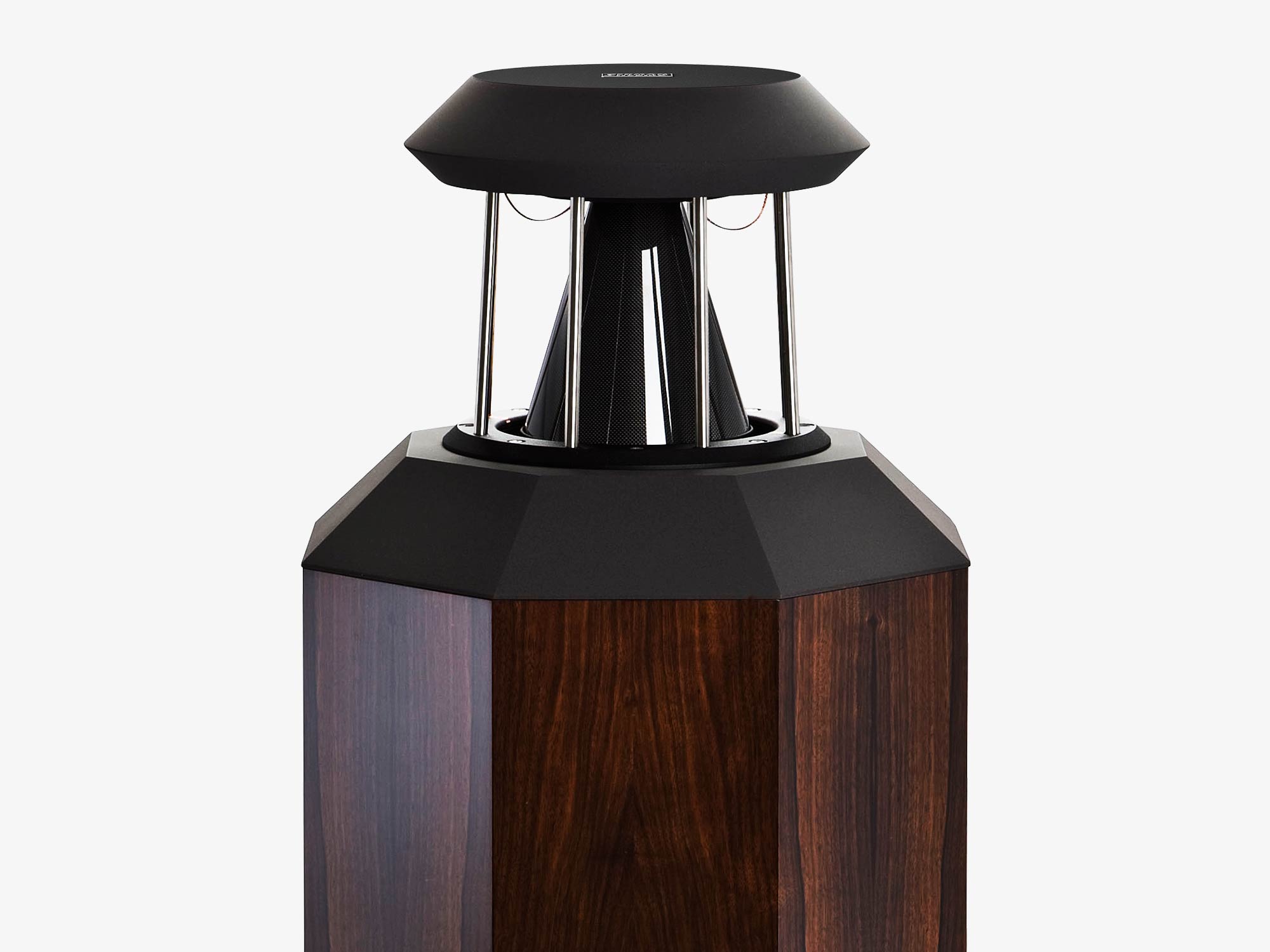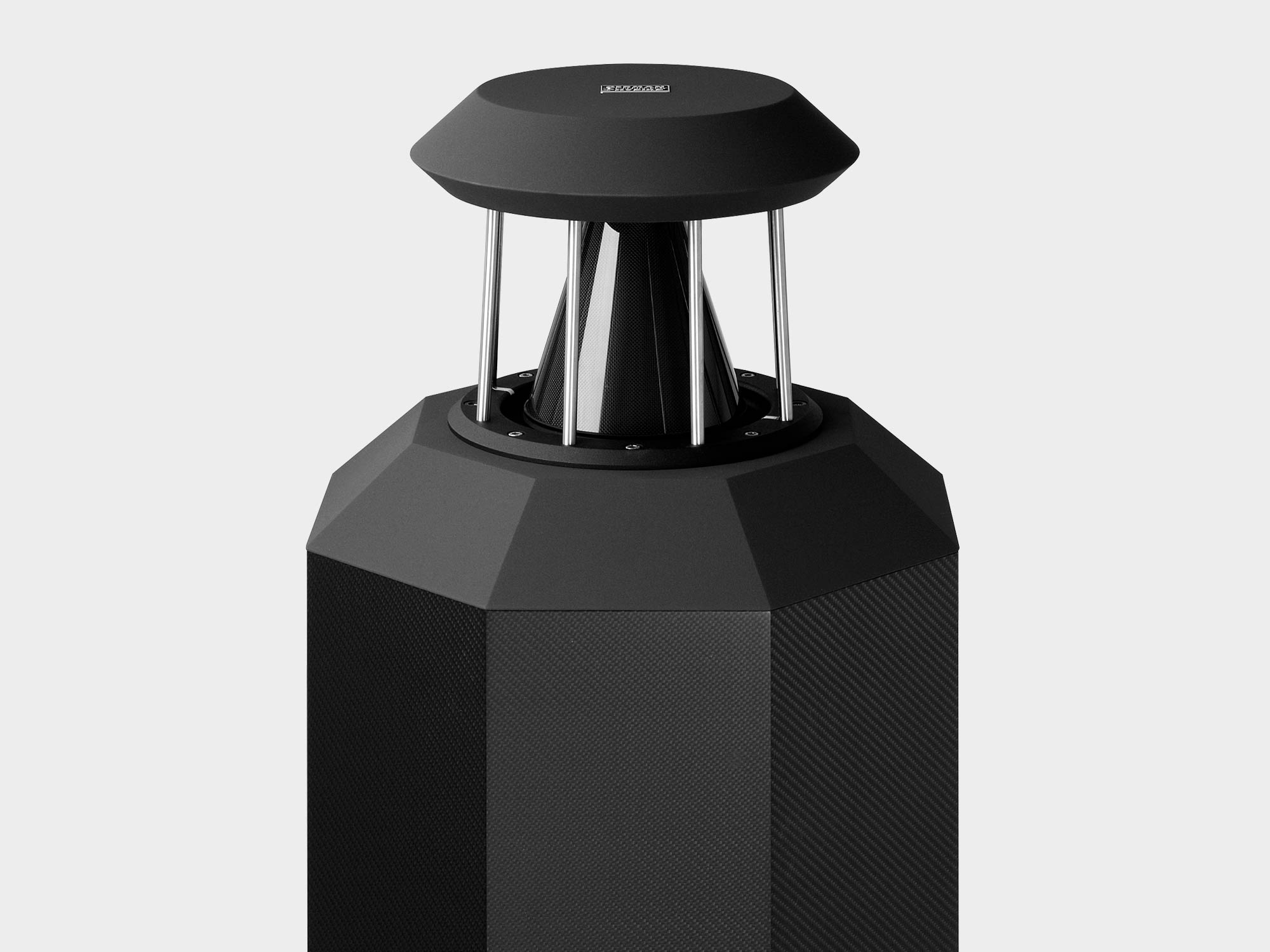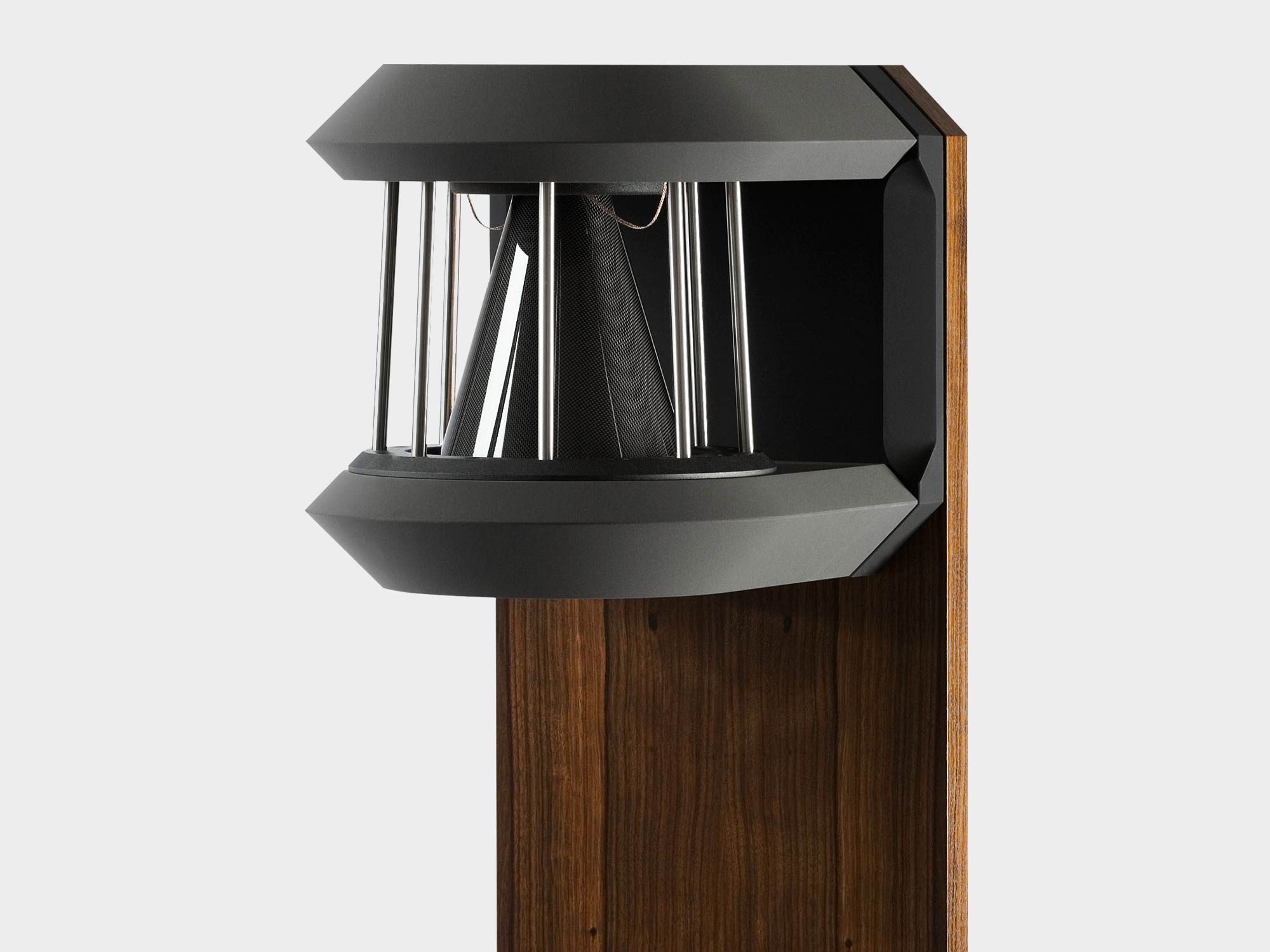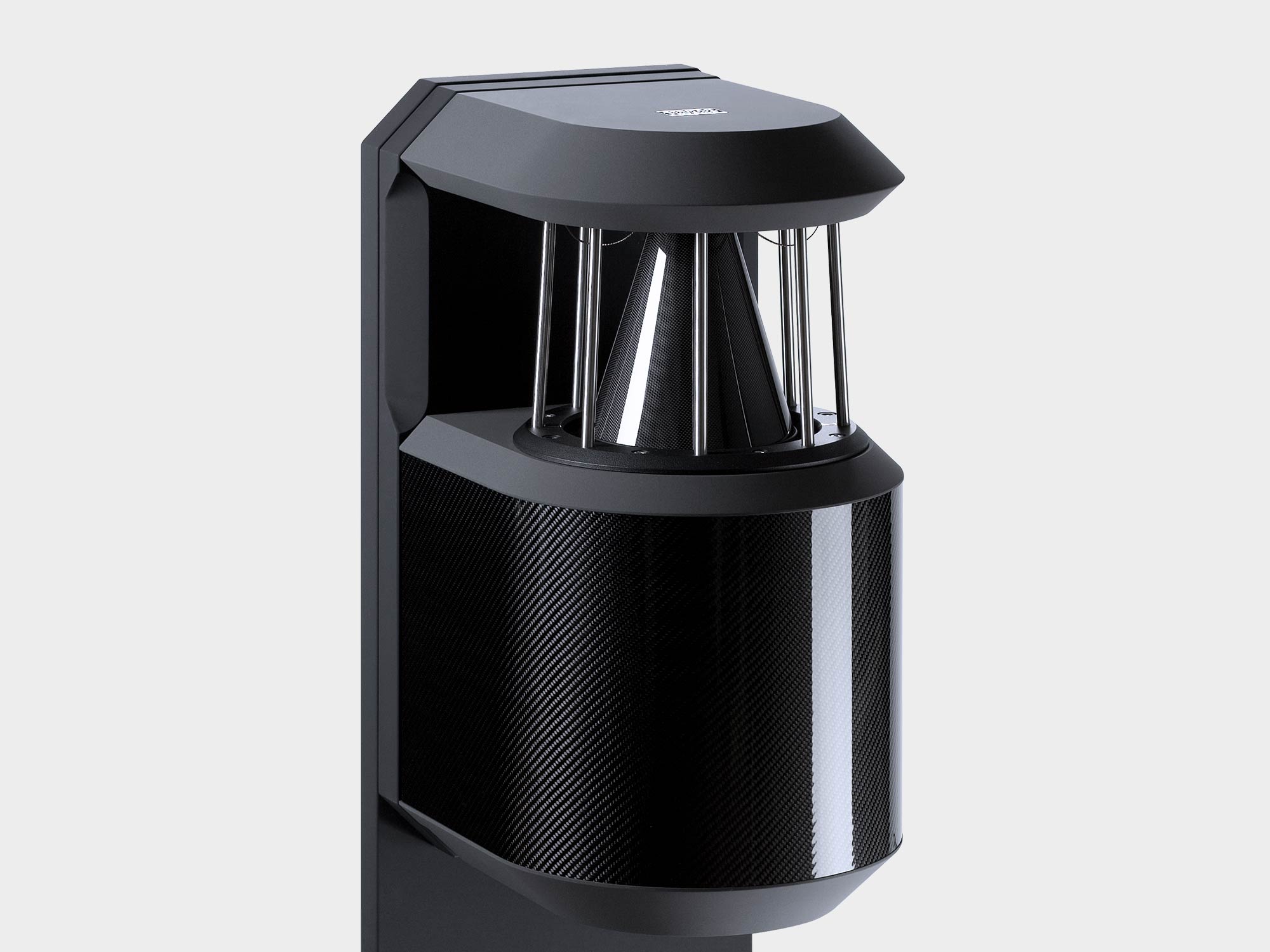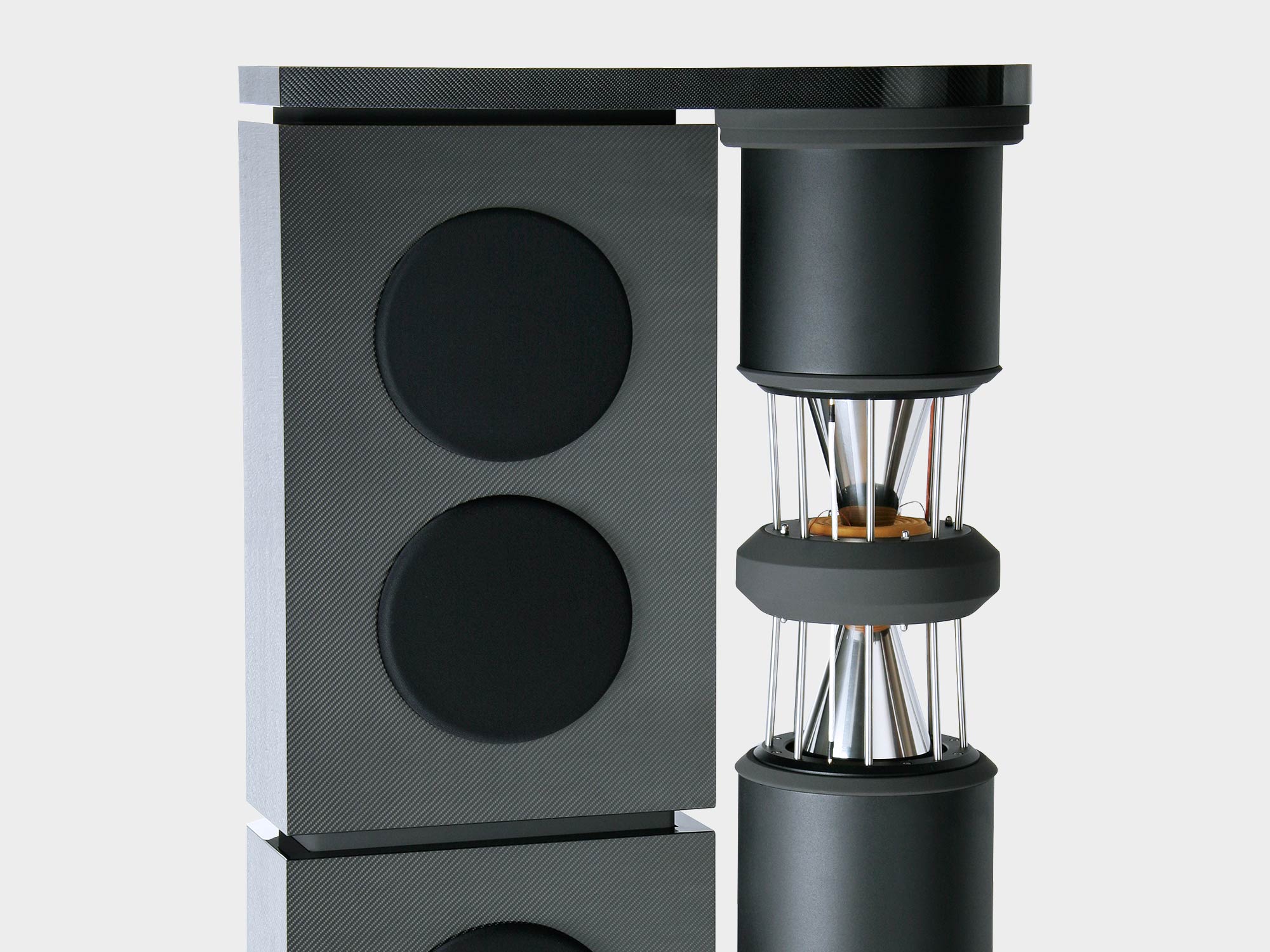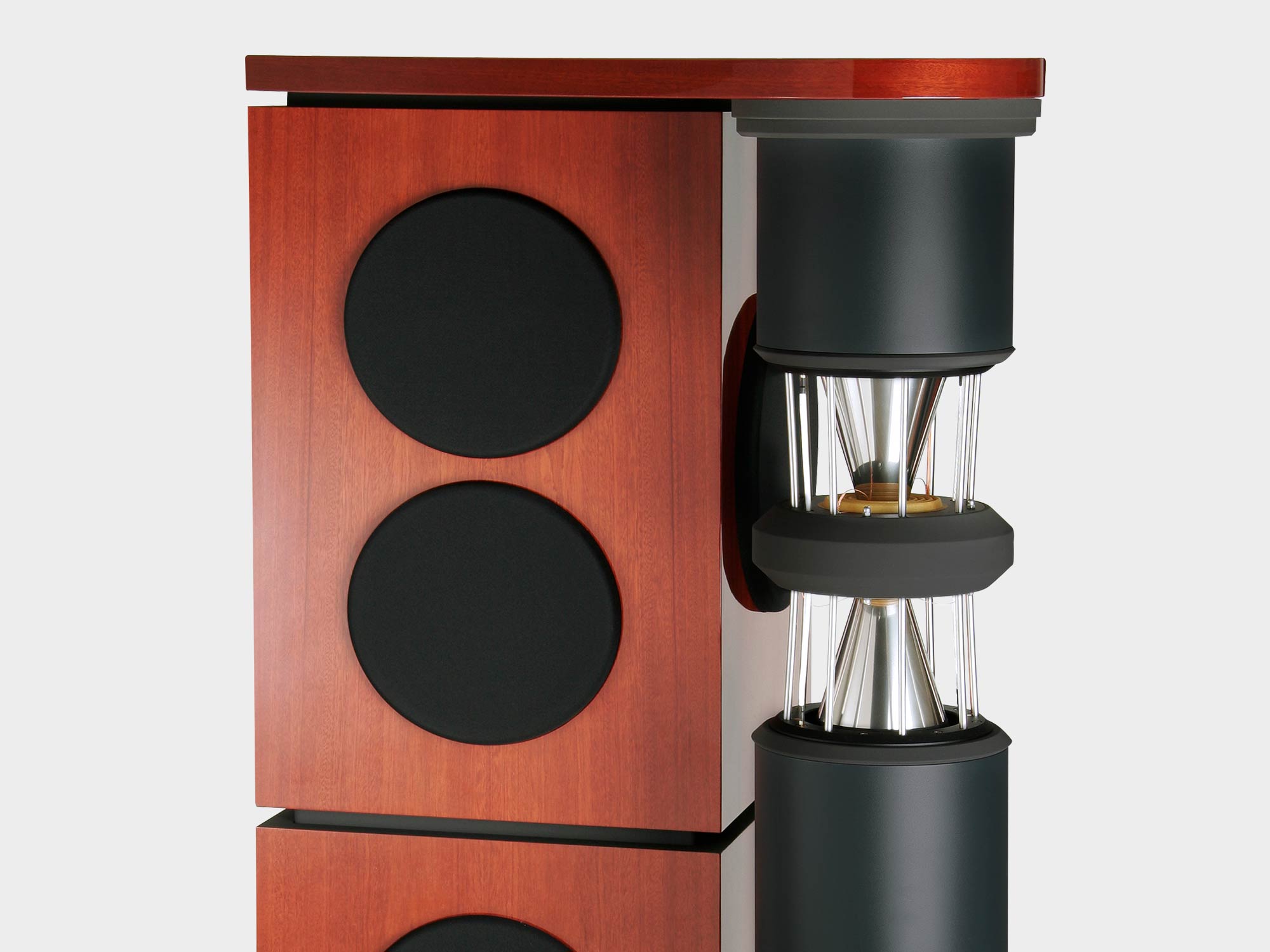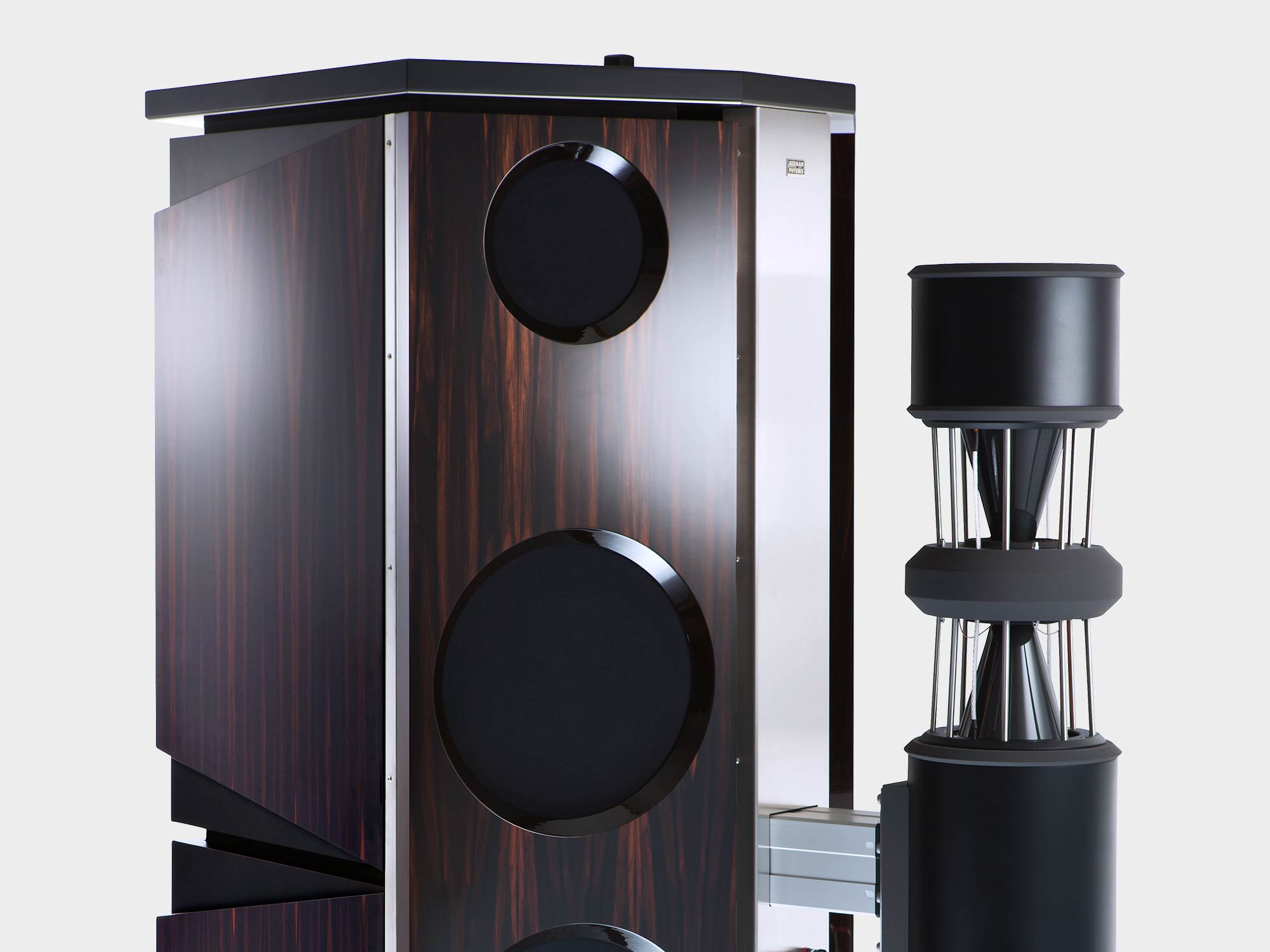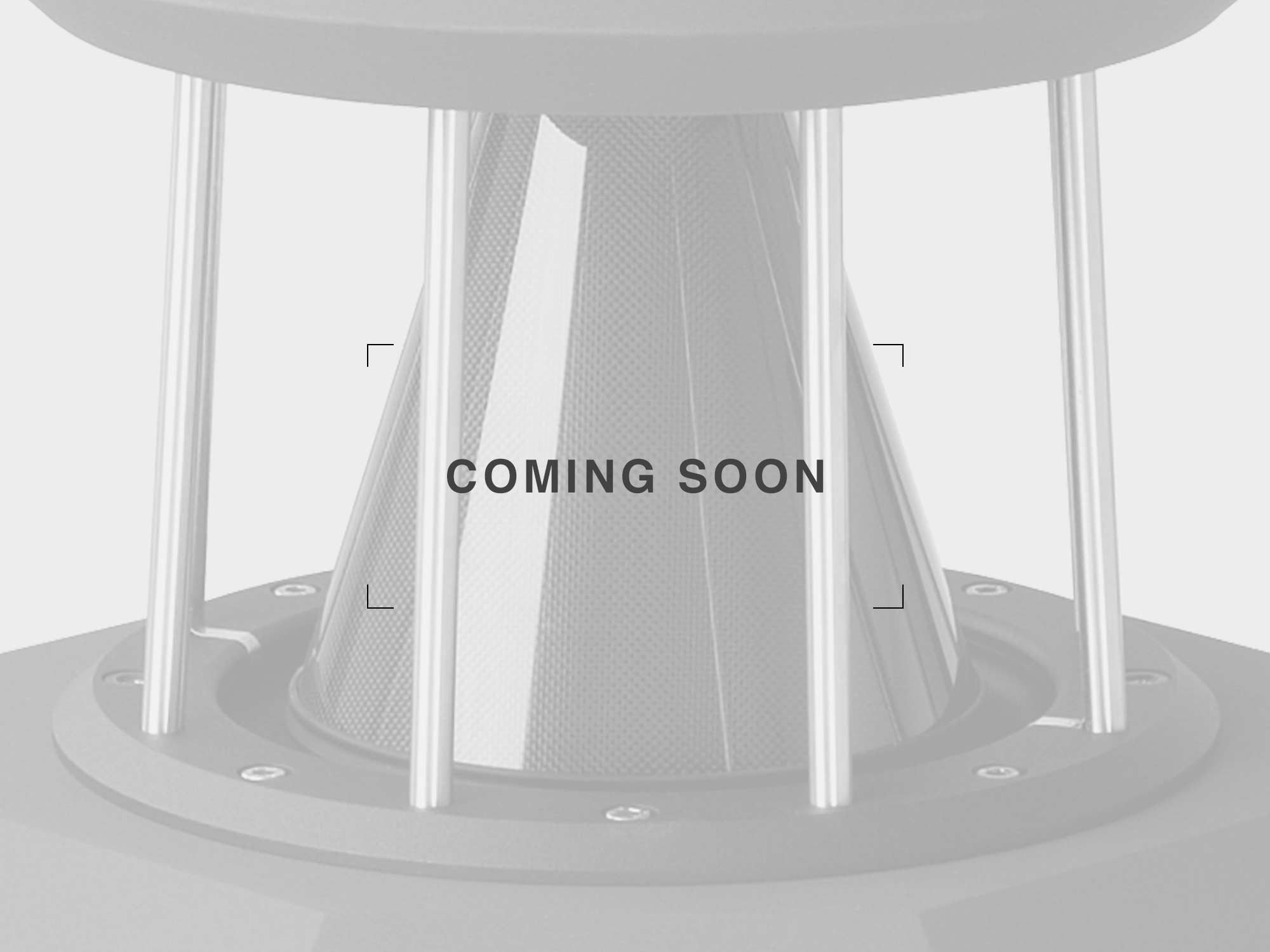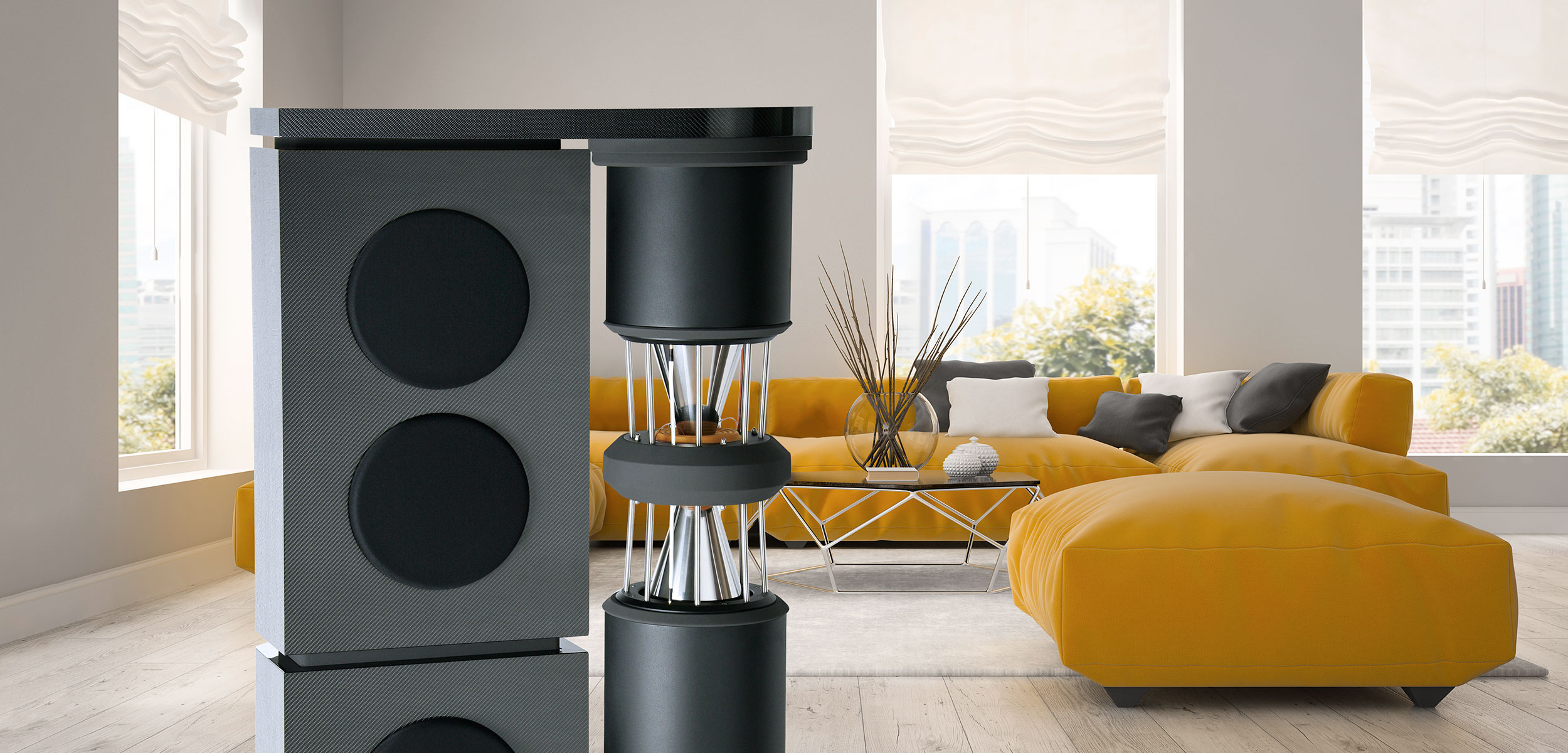

The design brief for the PQS-402 was to produce a listening experience comparable to that of our Loreley model from a loudspeaker with a smaller cabinet, thereby making our reference level products available to a wider audience. As well as the usual impressive German Physiks attributes, the PQS-402 also boasts a very wide dynamic range that comes close to its larger stable mate.
Award Winning Loudspeaker
Latest news about the PQS-402

The PQS-402 uses two DDD drivers, two 10-inch woofers and four 8-inch passive radiators to provide exceptional dynamics and resolution that will take you a step closer to a real performance
The bass system produces prodigious amounts of deep and well-controlled bass, that at the same time has the speed and finesse to perfectly match with the dual DDD drivers. The combined effect is a loudspeaker that can do equal justice to full-scale orchestral works, or a solo voice. This is further enhanced by the PQS-402’s very high maximum output level (118dB), which allows a closer approach to live music dynamics, without compression
The Problem
Because we wanted to cross over the DDD driver to the woofer between 220Hz and 140Hz, we had to find a way to build a very fast bass system that could match the speed of the DDD driver in the crossover region and also work down to 25Hz. To reproduce low bass at high levels a lot of air has be moved. This requires either a driver with a large surface area, which will be heavy and therefore not easy to move at the speed necessary to match the DDD driver, or a driver with a long excursion, which again will be heavy due to the rigidity required to withstand the necessary acceleration. Most loudspeaker designers solve this problem by producing a 3-way system. However, in a loudspeaker the size of the PQS-402, a 3-way solution would have been worse than a 2-way solution, due to the difficulty of making 3 drivers appear to be a single source. This is especially difficult with the mid and treble drivers, where the ear’s ability to locate position is very acute. It can be done, by why bother when you have a better solution?
The Solution
Our solution was to build a bass cabinet using a fast and powerful 10-inch driver and two 8-inch passive radiators. The 10-inch driver integrates flawlessly with the speed of the DDD drivers and the passive radiators extend the bass response smoothly down to 25Hz as required. The final system comprises 2 bass cabinets that are mounted one on top of the other and stand between a top and a bottom plate. None of these components is attached to the other using screws or any other form of hard connection. Instead they are held together by a system of interlocking collars. This, combined with the fact that the two cabinets have different weights, as do the top and bottom plates, means that resonances are reduced to negligible levels compared to a solid structure.
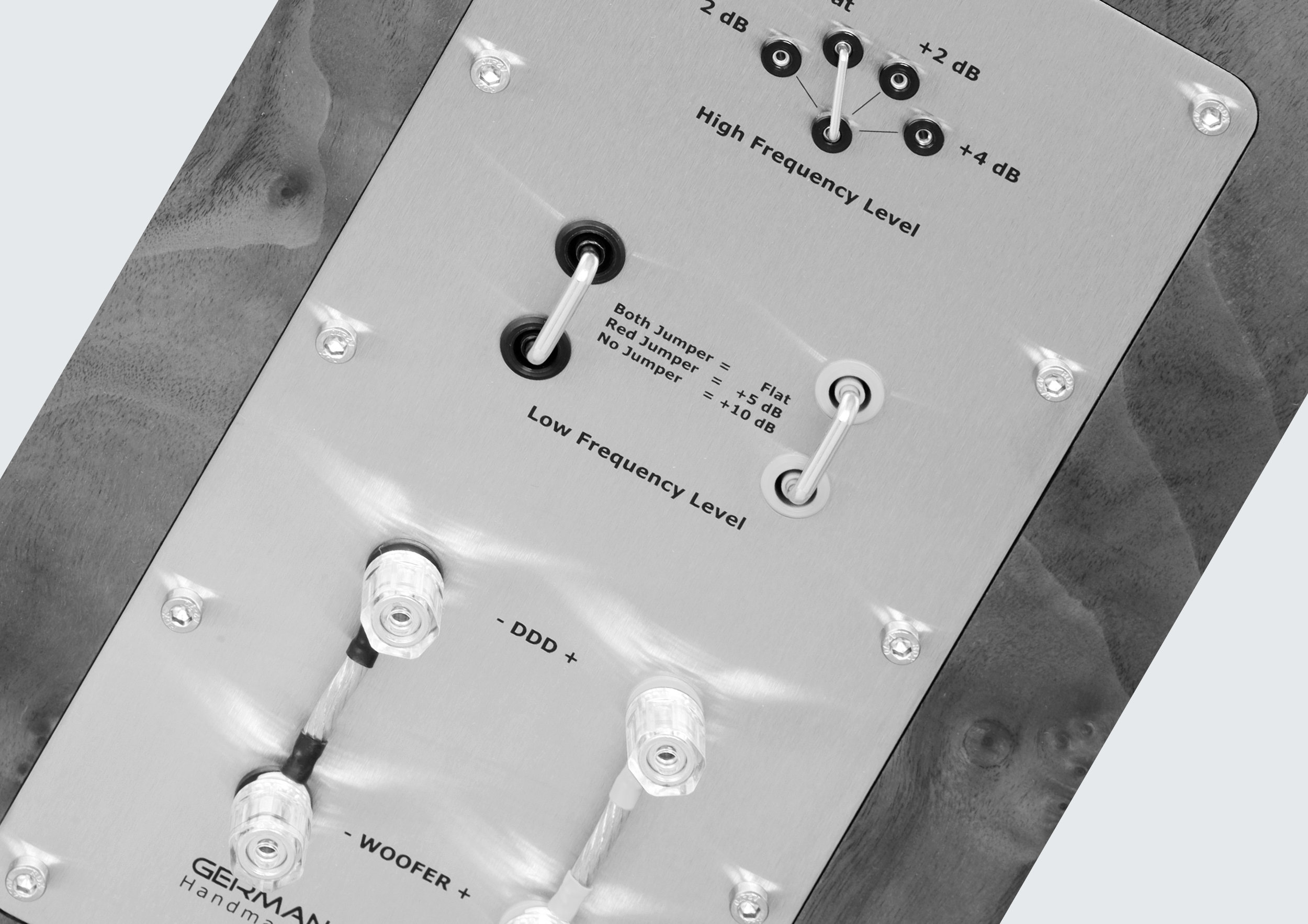
The heart of all German Physiks loudspeakers is the unique omnidirectional DDD driver
The German Physiks DDD driver uses a cone made of extremely thin (0.15mm) carbon fibre. This is very light, but also very rigid. Each driver is hand-built by a skilled technician in our factory in Germany. This is a painstaking process that takes 6 hours. After assembly, each driver undergoes a series of rigorous tests. It is then subject to a 96 hour pre-aging process, playing specially selected music at high level. Finally, it is retested and put together with another driver to form a matched pair.
The DDD driver has two key distinguishing features
1. It is omnidirectional, meaning that it radiates the sound evenly around it.
2. It has an exceptionally wide operating range. In the PQS-402 it covers the range from 215Hz up to 24kHz – almost 7 octaves.
This extremely wide range is achieved by the use of 3 modes of radiation
Pistonic radiation
Bending wave radiation
Modal radiation
By comparison, most loudspeakers use drivers that only use pistonic radiation. These have a much narrower operating range and as the frequency rises, they tend to concentrate their energy into a progressively narrowing beam. This is explained in more detail here.

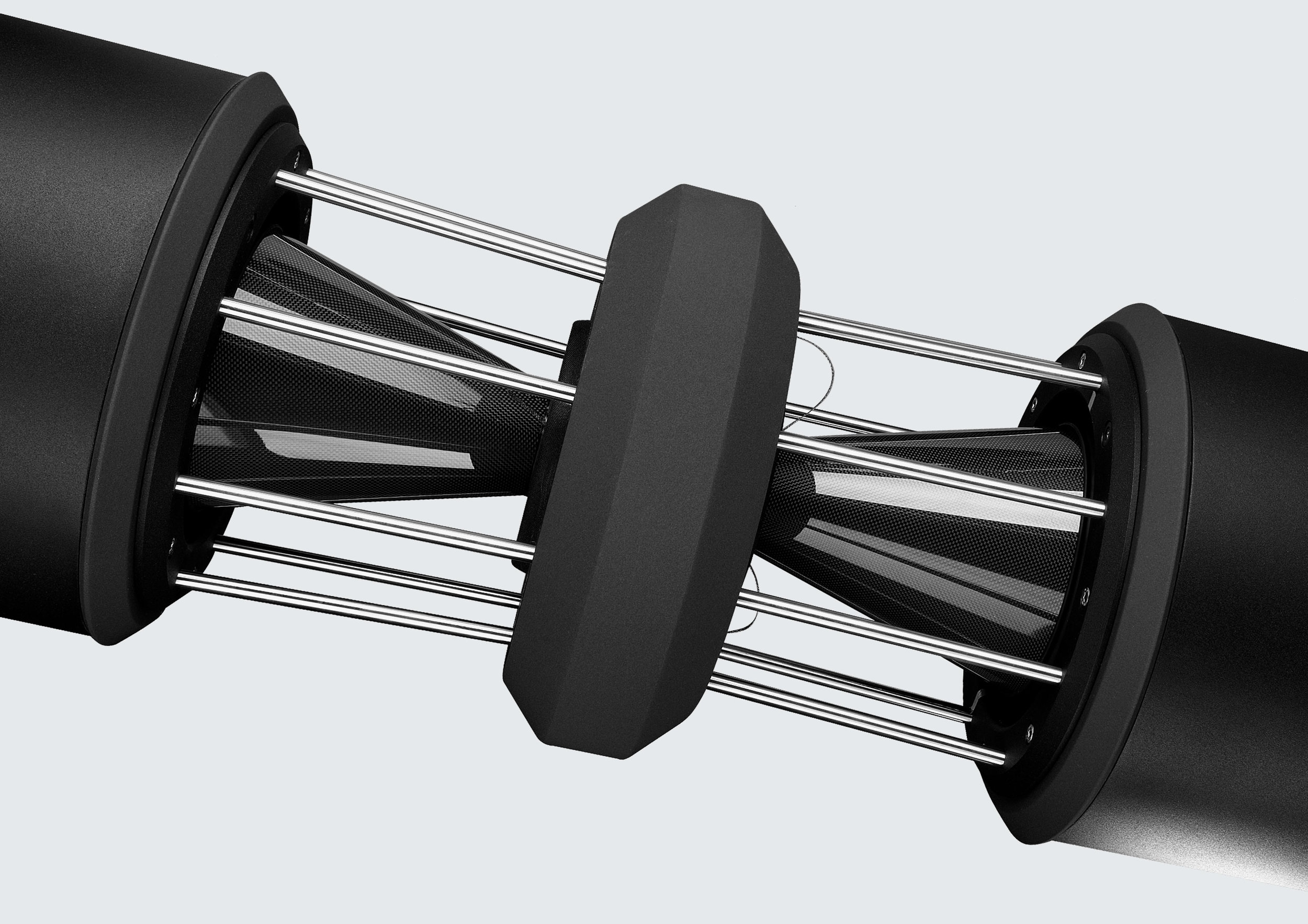
The DDD driver’s omnidirectional radiation characteristic and its very wide operating range, together with several other key features give the following important advantages to all German Physiks designs and is what sets them apart
1. Exceptionally coherent and natural sound
This is due to the DDD driver’s 7 octave plus operating range. This is very difficult to achieve when such a wide range is split over two or more different types of driver, which are in different positions on the loudspeaker’s cabinet.
This wide operating range also eliminates the crossover point in the mid-range that loudspeakers using pistonic drivers must have. This is where our hearing is most sensitive, so removing anything that might cause level or phase errors from here will improve transparency.
2. Realistic stereo images more like those you experience in the concert hall
This is because the DDD driver's omnidirectional radiation characteristic creates an enveloping sound field like that in the hall, rather than beaming the sound at you as conventional drivers do. This way the PQS-402 is able to recreate a more natural rendition of the original stereo image. This has excellent depth and focus, but without the overly sharp image definition that some hi-fi loudspeakers produce and which you will rarely if ever hear at a live performance.
3. Stereo imaging enjoyable in almost all positions in the room
This is achieved whilst also maintaining an even tonal balance, much like at a live performance: again due to the DDD driver’s omnidirectional radiation pattern. This gives more flexibility in where you sit and allows several people to enjoy a good sound together. This is useful in home theatre systems.
As you are not restricted to a small “sweet-spot” in order to hear the best sound, the PQS-402 provides a more relaxed listening experience. This is especially noticeable when you listen for long periods.
4. Exceptional dynamics
The DDD driver’s very low moving mass, less than 3 grams, allows German Physiks loudspeakers to recreate both the attack of the music and resolve low level detail very accurately. This is essential in order to faithfully reproduce the delicate nuances of a performance and make it sound like music, rather than just good hi-fi. The resultant transparency is maintained even on complex high-level passages.
5. Accurate portrayal of musical instruments’ tonal characteristics
This is because the DDD driver is phase linear across its operating range. This together with the excellent dynamic response, enables the PQS-402 to reproduce percussion with startling reality. Voices have a clarity and purity that can be breath taking, with all the elements of the vocal sound correctly located in space and with no undue emphasis. The hardness you often hear with conventional tweeters is eliminated and you get a greater sense of hearing a live musician.
6. Quick and easy to set up
As they are omnidirectional, German Physiks loudspeakers are less sensitive to room position than conventional designs and there is no toe-in adjustment to worry about.
7. The DDD driver is less likely to excite cabinet vibrations
Due to its very low moving mass and the way that it is mounted, the DDD driver puts less energy into the cabinet than an equivalent conventional driver. This reduces cabinet resonances and improves transparency.
8. Physically extremely rugged
The DDD driver can withstand abuse that will destroy most other drivers. Thisis illustrated in the video below. We don’t advise our customers to try this, just in case they are having an unlucky day.
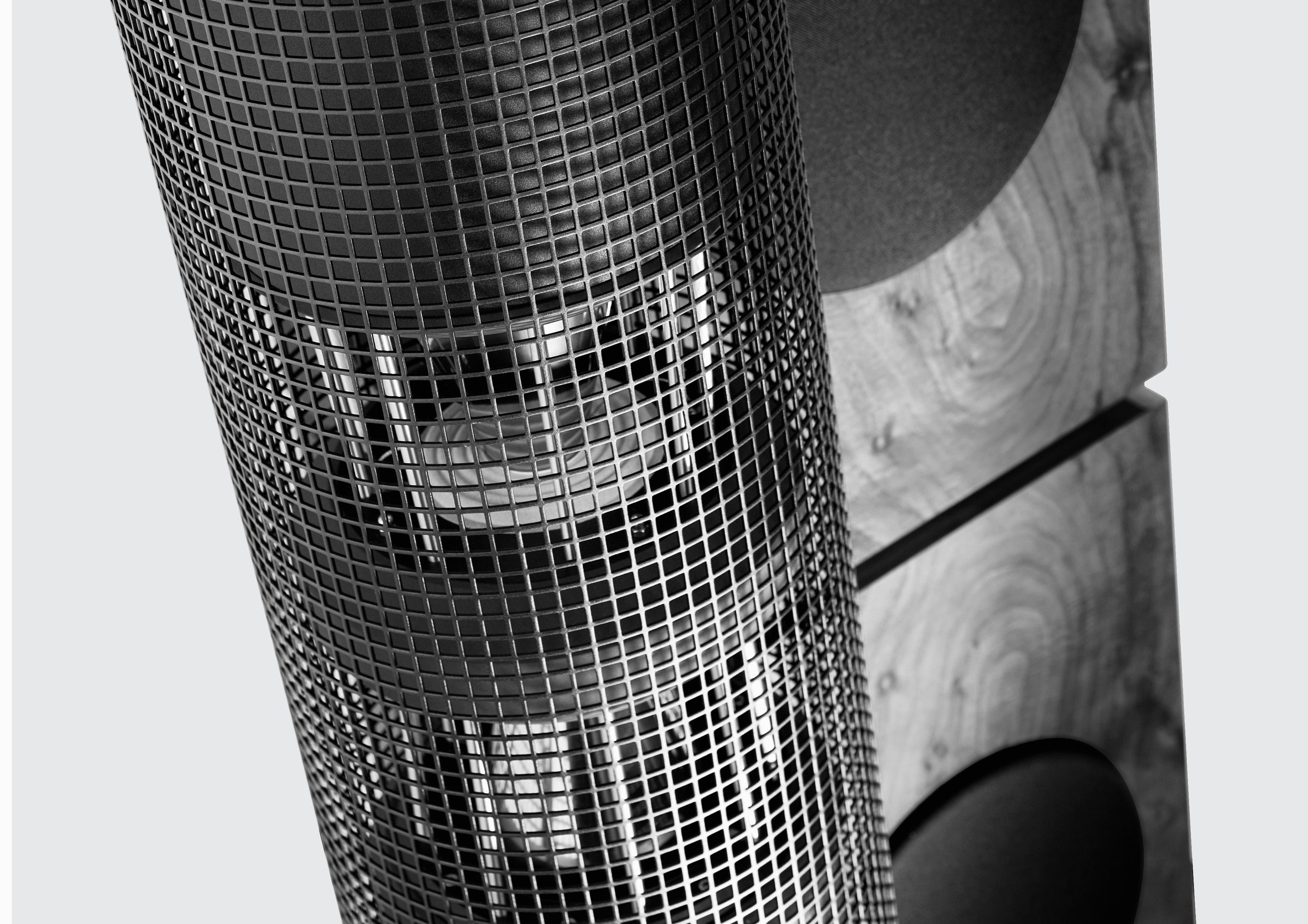
Low Resonance Cabinet Design Enhances Transparency
Colouration caused by resonances in a loudspeaker cabinet, where the cabinet itself starts to radiate sound energy,can seriously degrade the sound quality by obscuring detail. Because ofthe very high sound level capability of the PQS-402 (118dB), we went to great pains to design a cabinet where resonances were minimized, as these would otherwise degrade the loudspeaker’s ability to resolve the fine detail that is essential in order to produce a sense of realism and hence convey the emotion that is the essence of a musical performance.
The PQS-402’s DDD drivers use very small enclosures, minimizing the area of any potential vibrating surface. By being cylindrical, they eliminate the resonances that can arise with a conventional rectangular or square section cabinet. Because they are made from aluminium, a comparatively soft metal, residual vibration of the enclosure is minimized. The DDD driver enclosure end-caps are made from non-resonant MDF and the enclosure is packed with damping material to dissipate any standing waves. The result is that the PQS-402 has the clarity that we normally associate with electrostatic loudspeakers and for the same reason: they essentially have no enclosure to colour the sound.
The bass system, which covers the range from 215Hz downwards, is divided into two independent cabinets, so the panels are smaller and therefore stiffer and more vibration-resistant than if a single large enclosure had been used. All the cabinet vertical surfaces are non-parallel to prevent the formation of standing waves between them. Internal bracing increases rigidity to suppress resonances. Residual vibration is minimized by applying a special damping material called Hawaphon®, to the inside surface of each panel.
Hawaphon® consists of a polymer sheet containing a matrix of small cells filled with fine steel shot. It adds mass to the panels to reduce the resonant frequency and the ability of the balls in each cell to move against each other provides a very effective way of converting vibration energy into heat. Originally developed as an anti-surveillance measure for use in military and government buildings, Hawaphon® achieves broadband attenuation of structure-borne sound of more than 50dB, which is an exceptionally high figure.
To damp resonances of the air within the cabinet, the whole of the interior is lined with a 1cm thick layer of high-density felt. This is achieved by fitting pieces of felt that are precisely cut to fit each panel, rather than just inserting a roll of felt into the cabinet. This is a time consuming process, but we believe produces a superior result and is typical of the attention to detail that we lavish on all of our products.
Patented Crossover Design
The crossover provides a wide range of adjustment to allow the PQS-402 to be better set up to suit the user’s listening room. The high frequency level may be adjusted over the range -2dB to +4dB in 4 steps and the low frequency level may be adjusted over the range +10dB to 0dB in 3 steps. The low frequency control has no effect above 100Hz and we have applied for two patents to cover the novel approach that we developed to achieve this. Both controls are facilitated by high quality jumpers located on the loudspeaker’s rear panel and may be quickly and easily adjusted.
Bi-wire or Bi-amp
Two sets of high quality WBT nextgen™ loudspeaker terminals are fitted allowing the PQS-402 to be bi-wired or bi-amped. High quality jumpers are supplied to enable the loudspeaker to be used with just one set of loudspeaker cables.
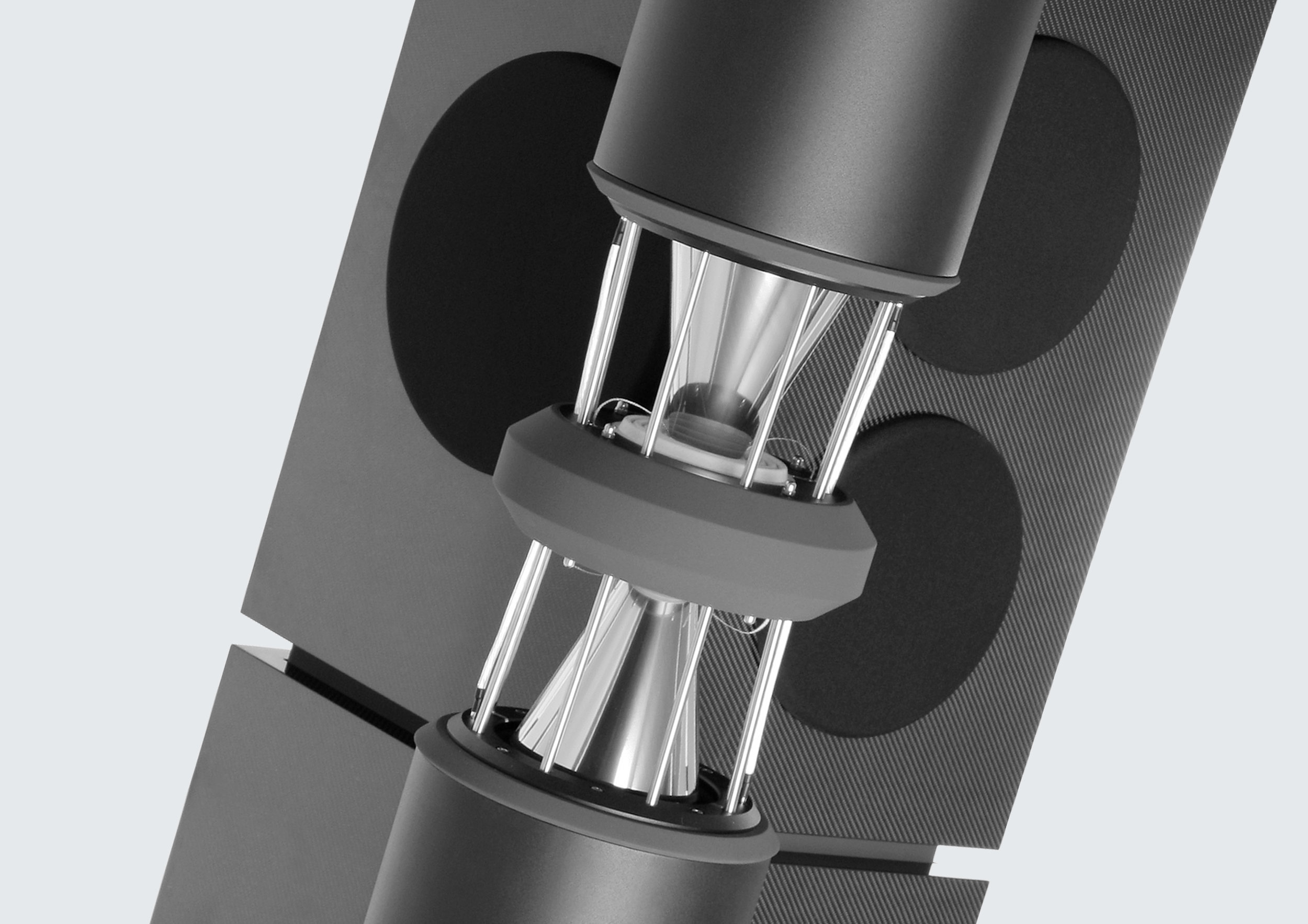
The Emperor Extreme Crossover active option provides a significant performance upgrade
The PQS-402 may be ordered in an active version, where the internal passive crossover is omitted and the woofer and DDD driver sections of the loudspeaker are driven directly by two separate power amplifiers. This allows much better damping and control of the drivers and provides a noticeable improvement in transparency.
The table below shows the recommended amplifier rating for each section of the loudspeaker:
| Section | Minimum Power |
|---|---|
| DDD drivers | 125W/4 ohms |
| Woofers | 180W/4 ohms |
Emperor Extreme Crossover
Emperor Extreme Crossover
The active version of the PQS-402 is supplied with our new Emperor Extreme DSP based digital crossover. This is a high quality unit constructed using premium components and is housed in a heavy steel and aluminium chassis.
The crossover is preconfigured at the factory allowing the customer to use it straight away without needing to make any further adjustments. The customer can manually adjust the settings if they wish.
The system allows a number of crossover set-ups to be stored and quickly recalled. This makes it easy to experiment with new settings, safe in the knowledge that the original settings can easily be restored.
For further information on the Emperor Extreme Crossover click here.

Designed for a Lifetime of Listening Pleasure
As you would expect from a German product, the quality of construction and reliability are first class. We use the same quality of parts in the PQS-402 as in our reference products, where we design for a minimum life expectancy of 25 years. For this reason we have selected highly corrosion resistant V4 grade stainless steel for the DDD driver support pillars, terminal mounting plates and all the screws.
To ensure the long term stability of the bass cabinets, a veneer layer is applied to the inside surfaces. This equalises any stress that might be generated by the outer veneer due to changes in humidity and which could otherwise cause panels to warp.
Meticulous care and attention is paid during the manufacture of the PQS-402. Prior to assembly all components and materials are subject to a rigorous inspection. We also carry out detailed inspections at each stage of the manufacturing process. We can afford to do this as we build our products by hand in small batches. After assembly, the performance of each loudspeaker is measured. Then it is burnt in for at least 12 hours and measured again. Once the burn process is complete each loudspeaker is given a final detailed physical inspection before being packed.

Product Finishes
The PQS-402 loudspeaker is available in black or white high-polish polyester; a wide range of high quality veneers in both satin and high gloss lacquer; satin and high gloss automotive paint finishes and carbon fibre.
Finish Options
- High Polish Only*
- Satin Only**
- Satin or High Polish***
Hand Finished For Ultimate Quality
Because the look of our products is as important as the sound, all cabinets are hand built and finished in Germany by skilled cabinet makers for the best possible furniture grade finish.
They are built in small batches, so that they can maintain a consistently high level of quality. Nothing is rushed.
Click on an image below to see a finish in more detail.

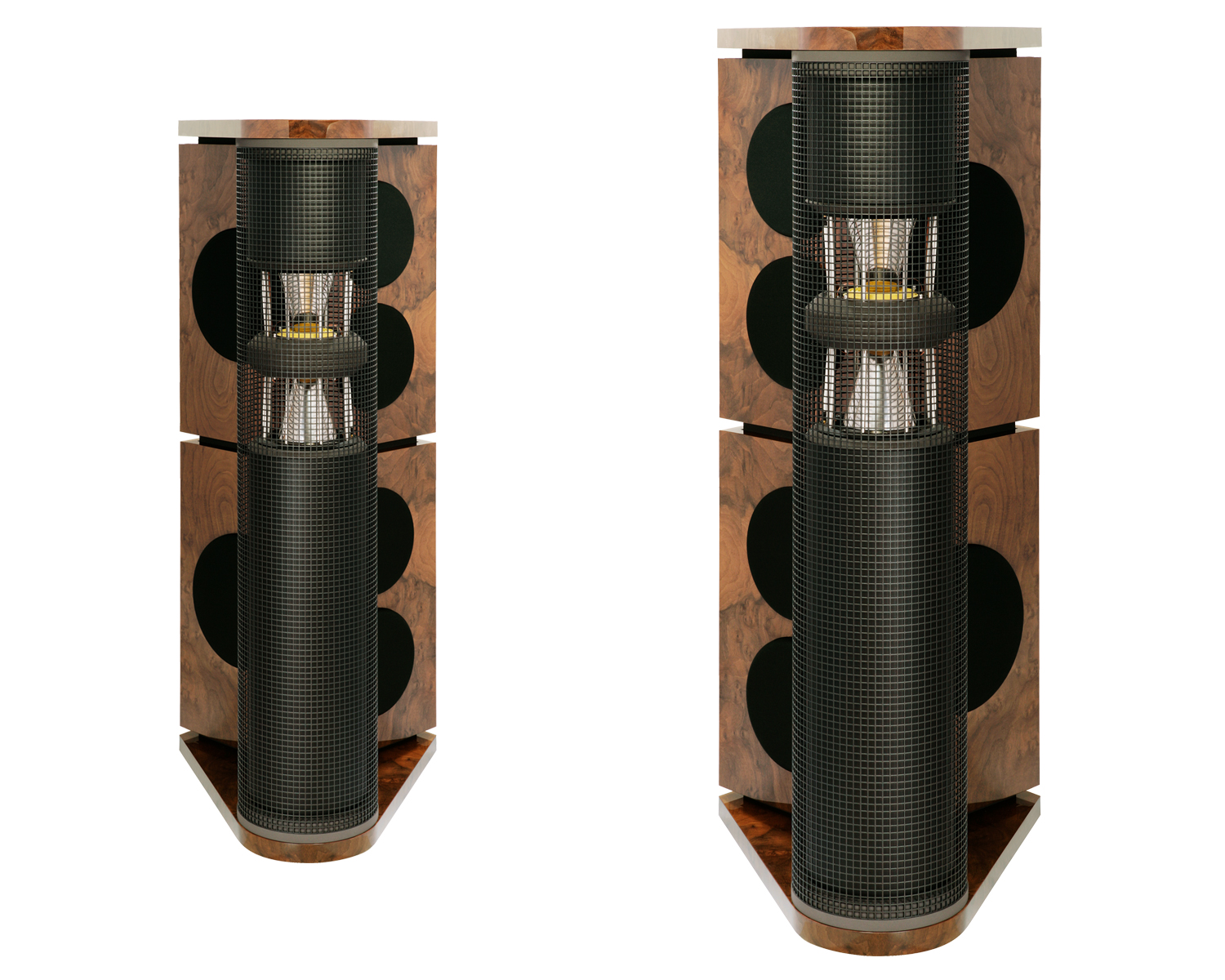
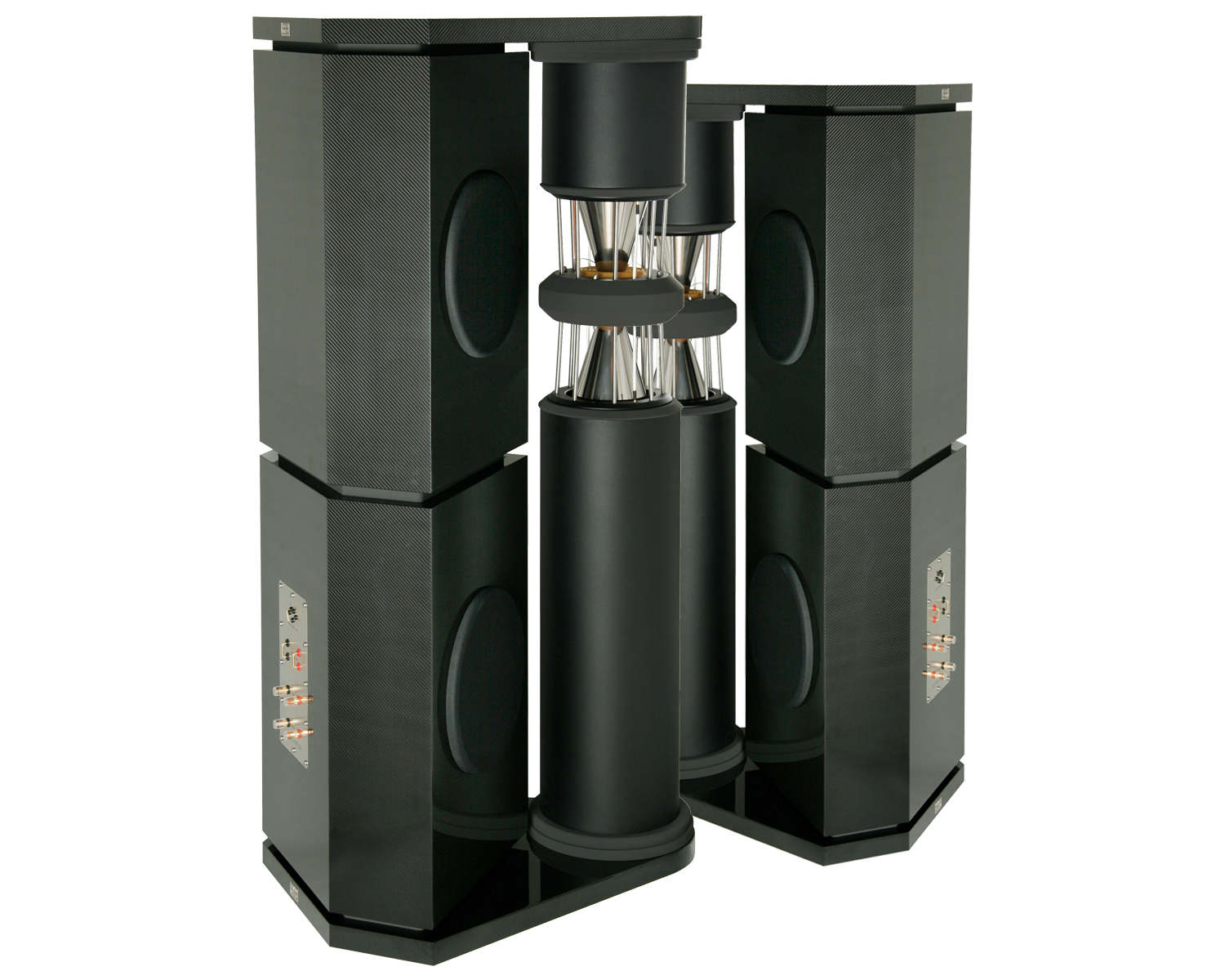
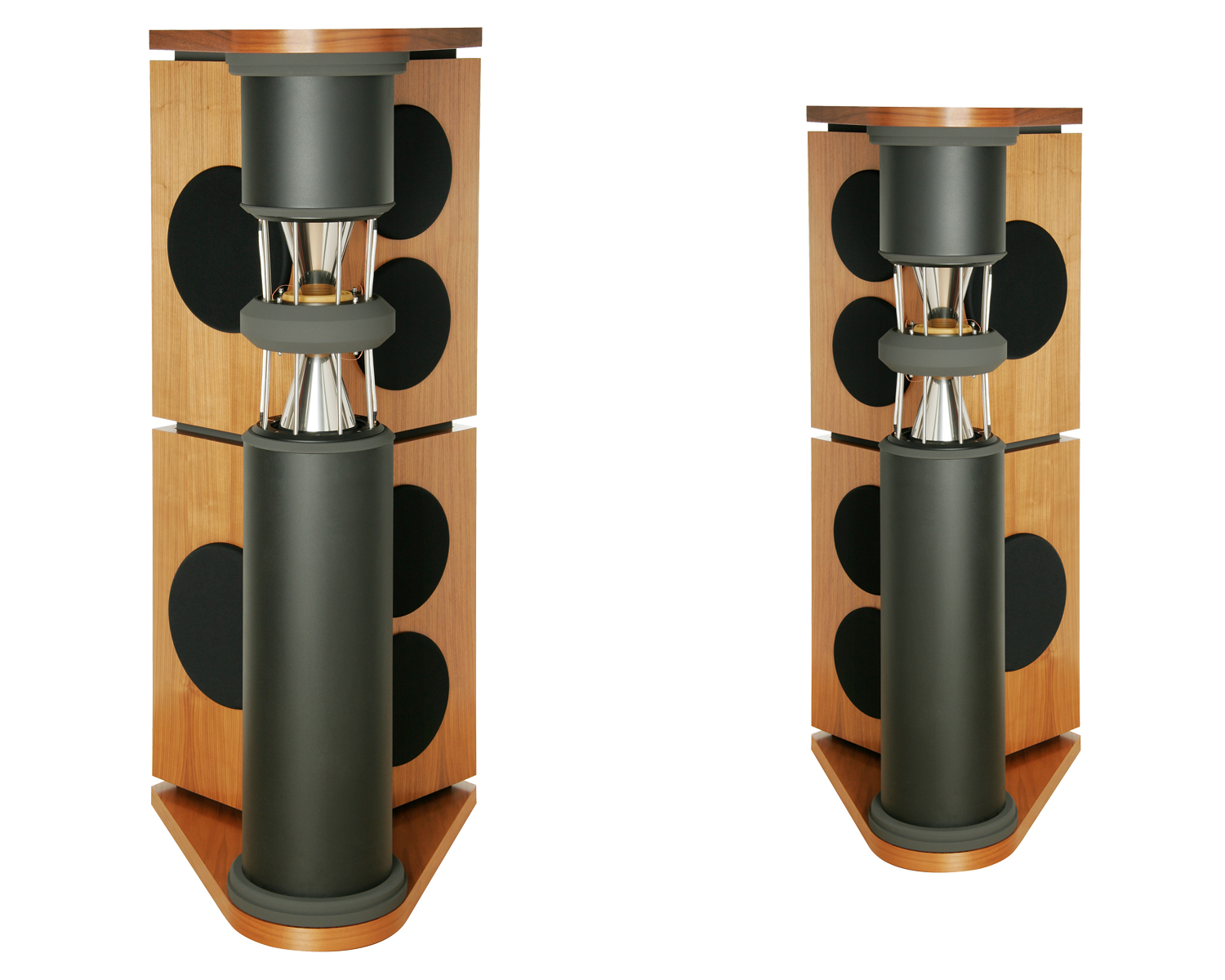
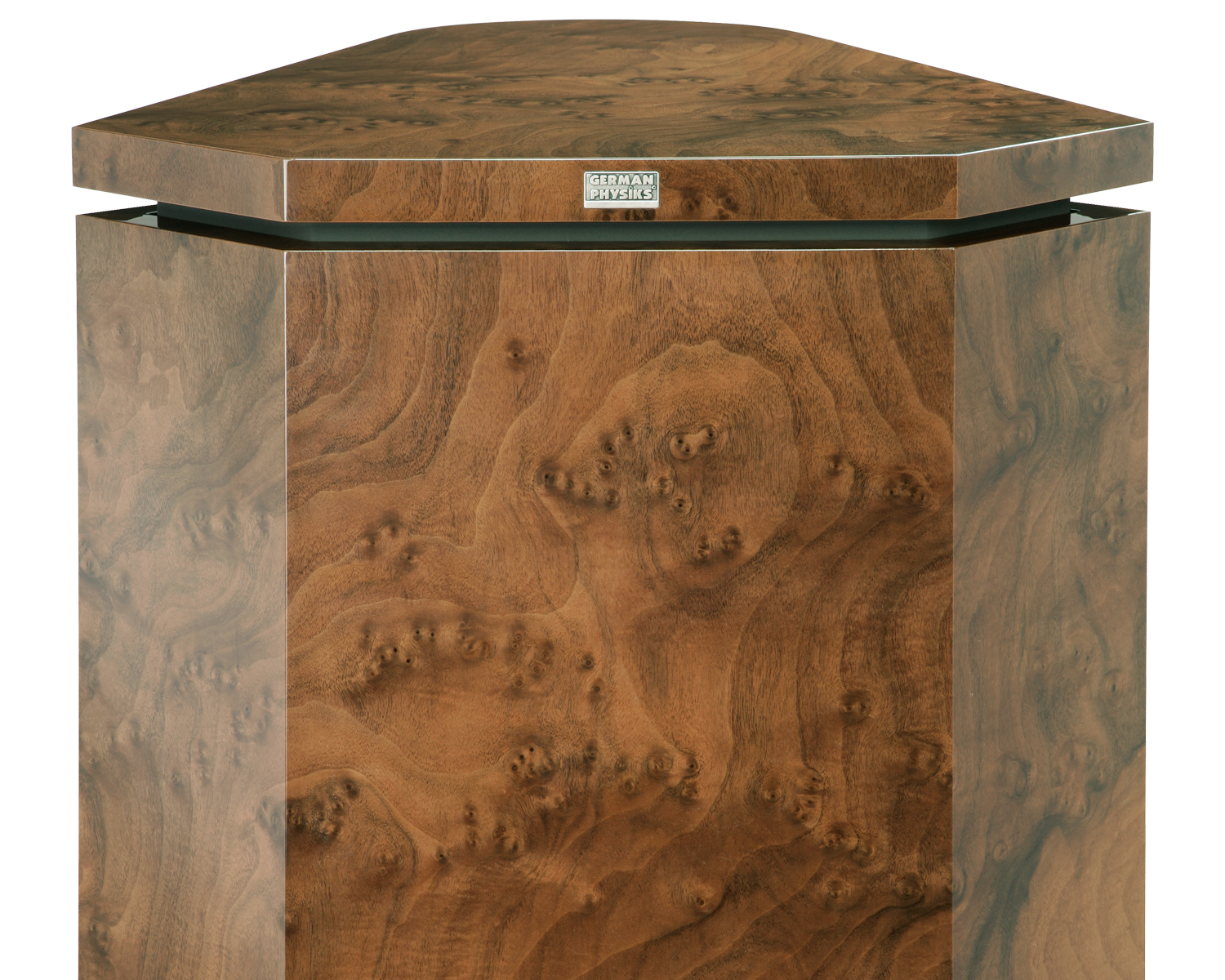
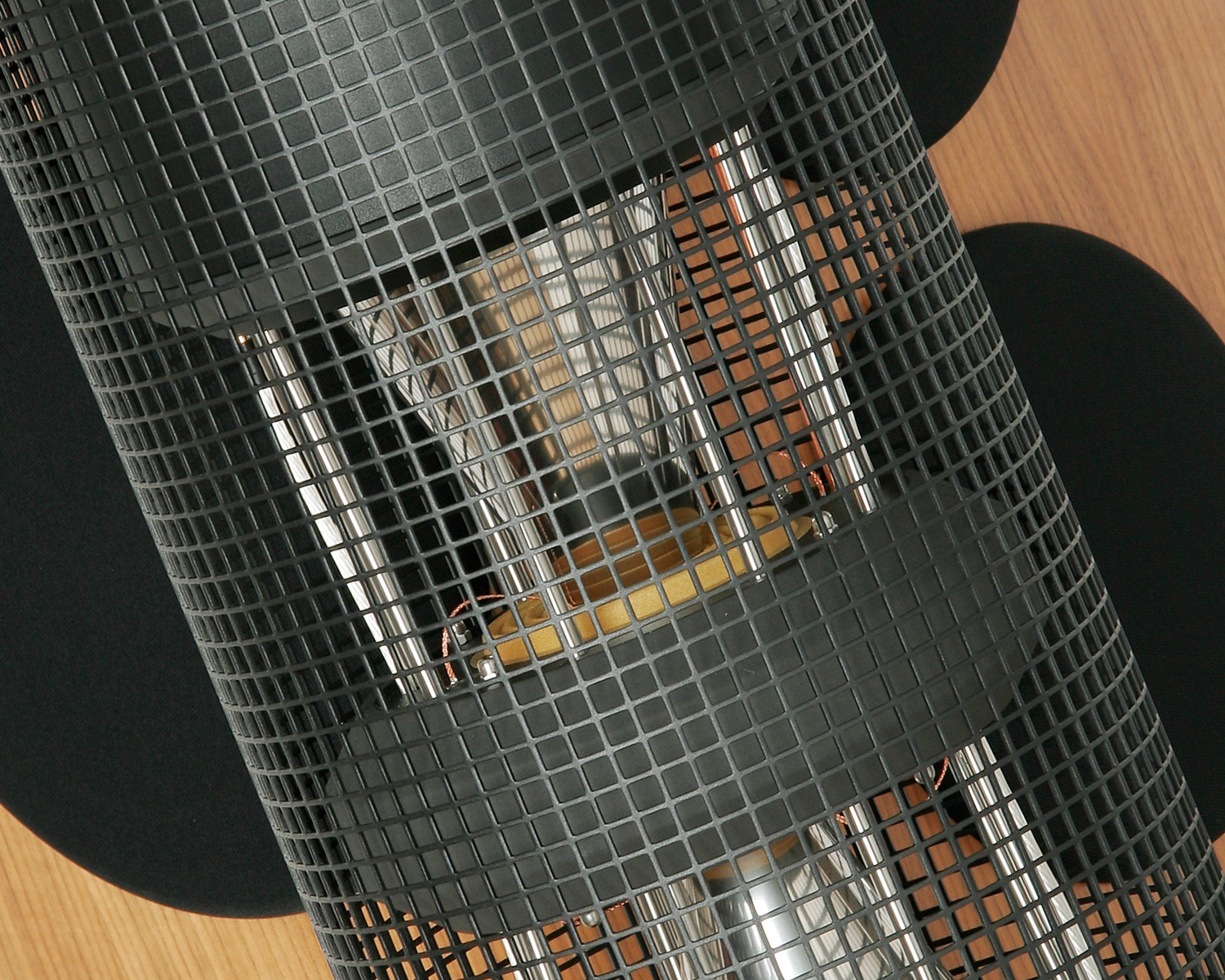
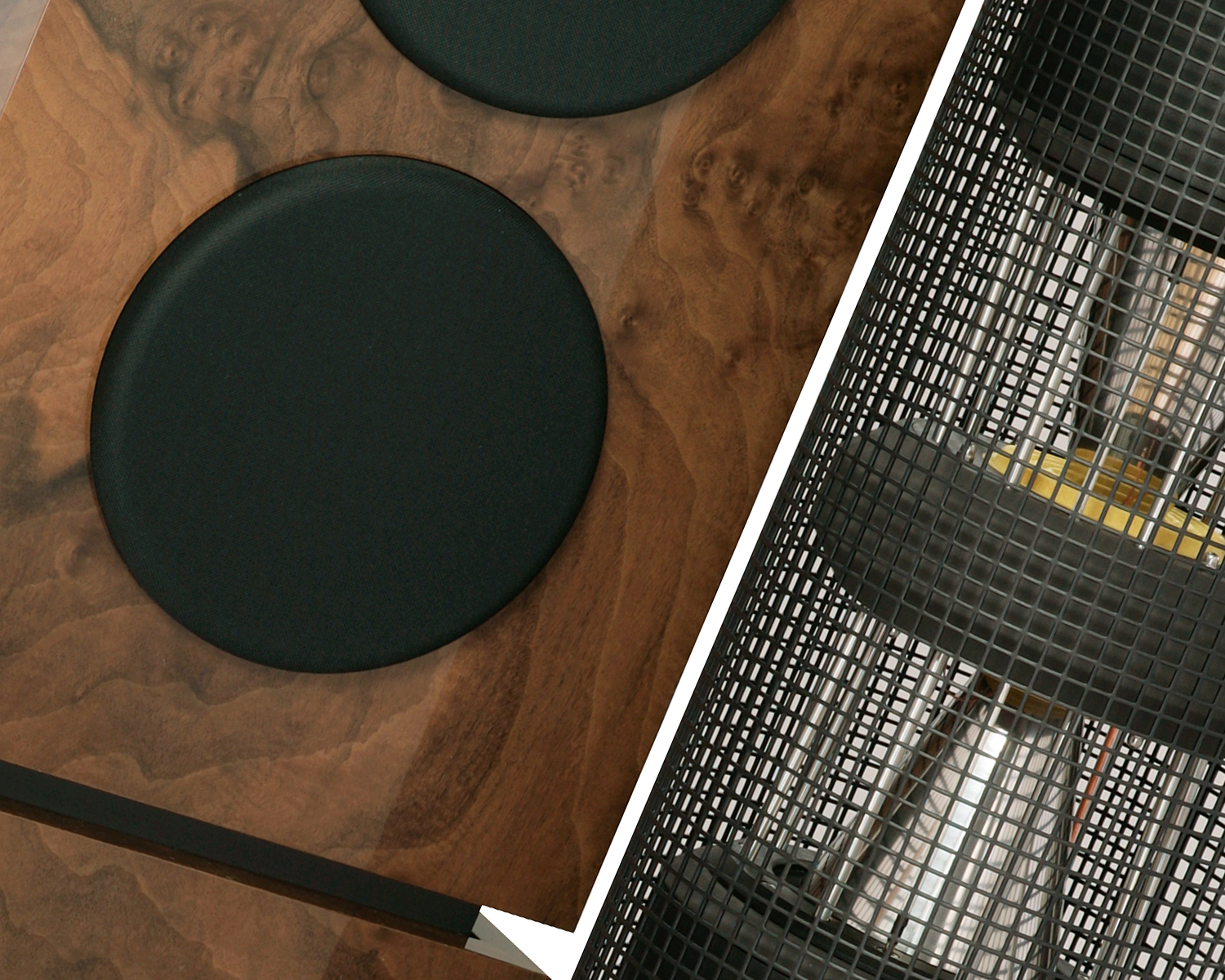
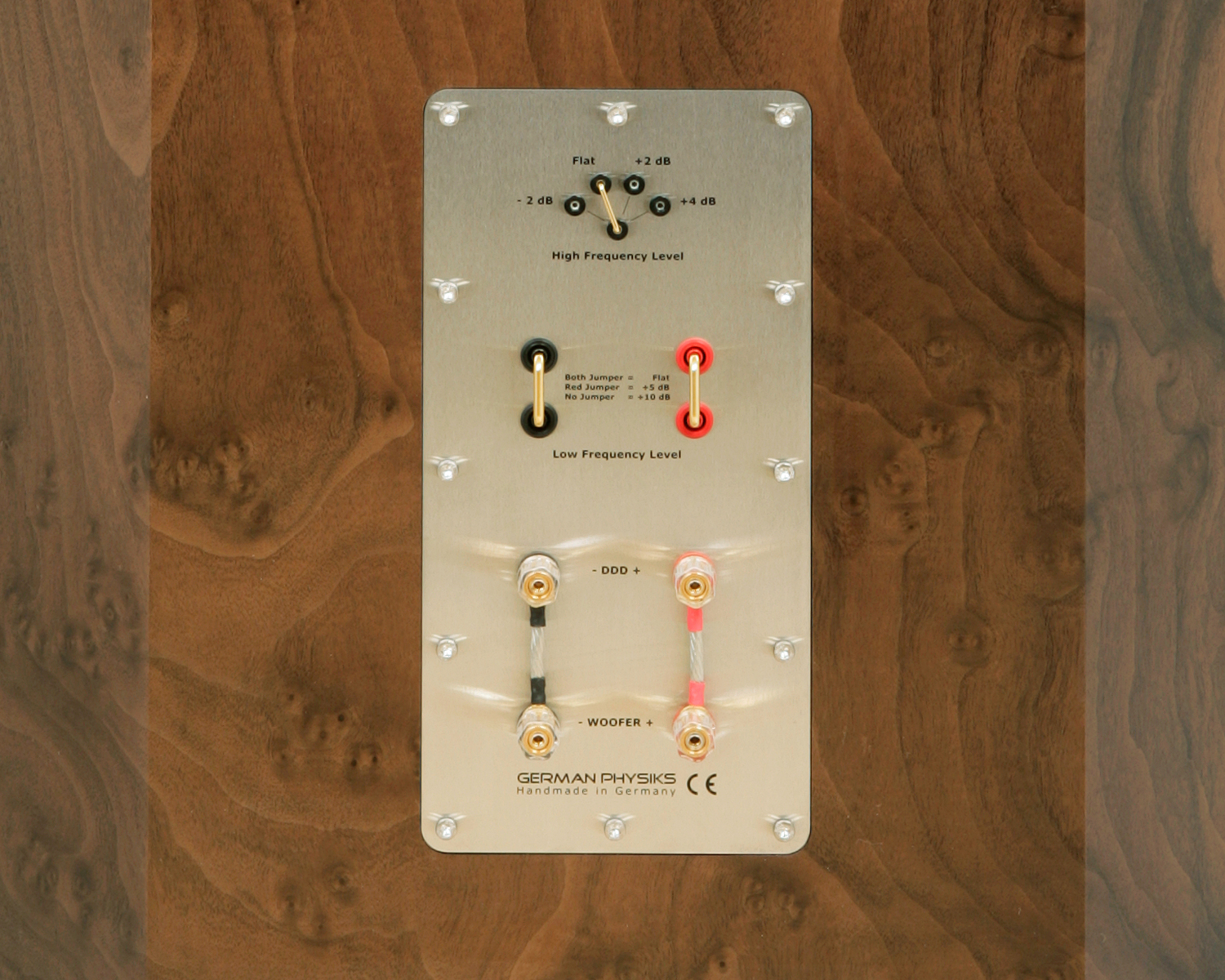
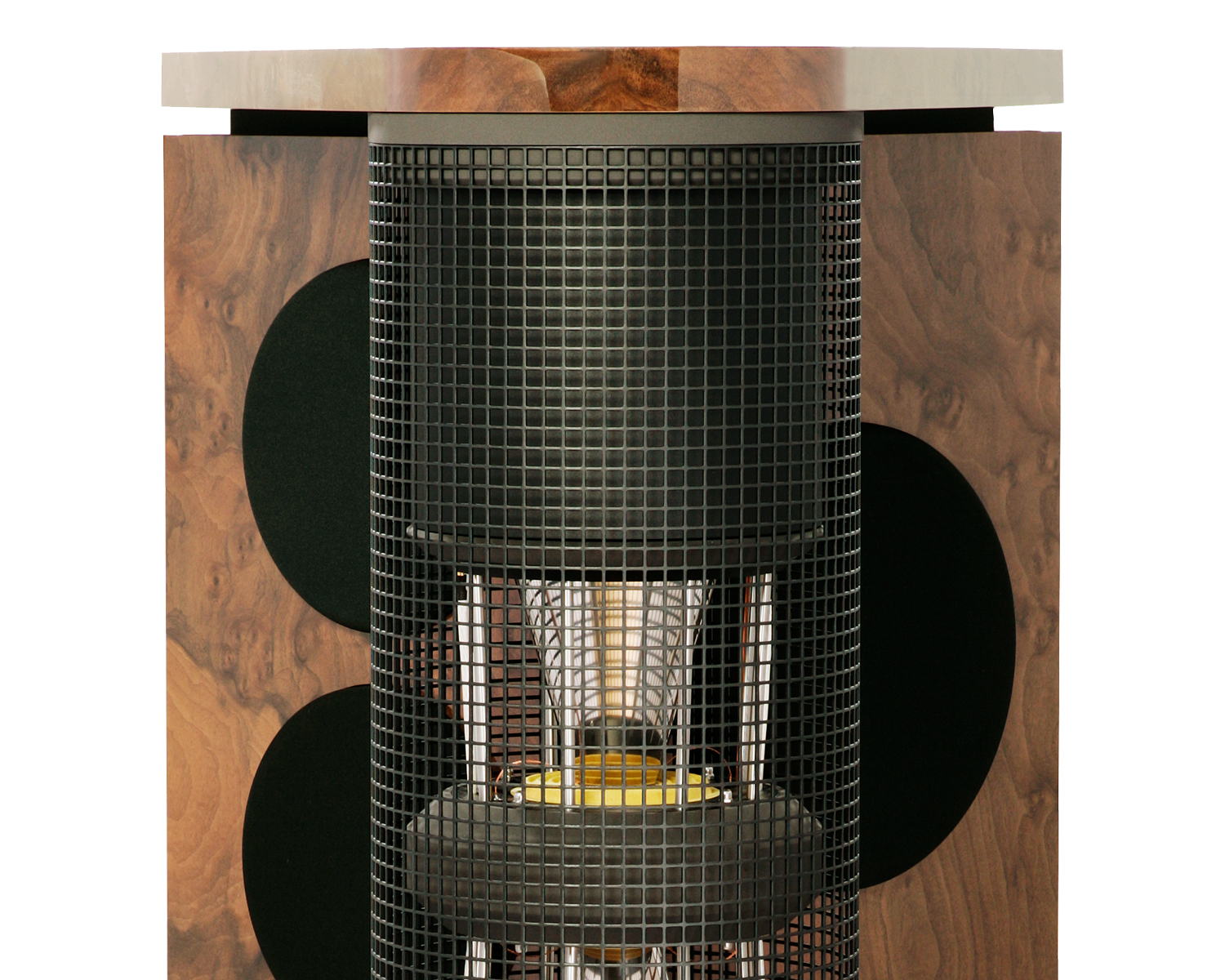
Product Specifications
Impedance
4 ohms
Frequency response
24 – 24,000Hz
Power handling
Nominal 450W
Short term 750W
Amplification required
Passive operation
1 power amplifier per channel
Minimum 200W/4 ohms
2 power amplifiers per channel
DDD section minimum 140W/4ohms
Sub-woofer section minimum 200W/4ohms
With active crossover
2 power amplifiers per channel
DDD section minimum 125W/4ohms
Woofer section minimum 180W/4 ohms
Crossover frequency
215Hz
Crossover slope (Passive version)
DDD section 12dB/octave electronic & 18dB/octave acoustic
Woofer section 18dB/octave electronic & 24dB/octave acoustic
Passive crossover adjustment
-2dB, flat, +2dB and +4dB centred at 8,000Hz
+10dB, +5db and Flat centred at 65Hz
Sensitivity
88.4 dB for 1W at 1m
Maximum output level
118dB
Operating principle
2-way loudspeaker with 360° surround radiation
using the German Physiks DDD driver
Input connectors
2 sets of WBT nextgen™ binding posts
Drivers
2 x carbon fibre DDD drivers
2 x 10-inch woofers
4 x 8-inch passive radiators
Recommended room size
30 - 150 square metres
317 – 1,584 square feet
Finish options
Satin or high polish veneer
High polish polyester black or white
Satin or high polish paint
Carbon fibre
Dimensions
620mm W x 1,560mm H x 750mm D
24.4" W x 61.4" H x 29.5" D
Weight
165kg / 363lbs
Warranty
5 years
As part of our process of continually improving our products, we reserve the right to change specifications without notice.

Product Reviews
2015
Publication: New HiFi
Date: 2015
Country: Taiwan
Language: Mandarin
Product: PQS-402
view/download pdf (7mb)














